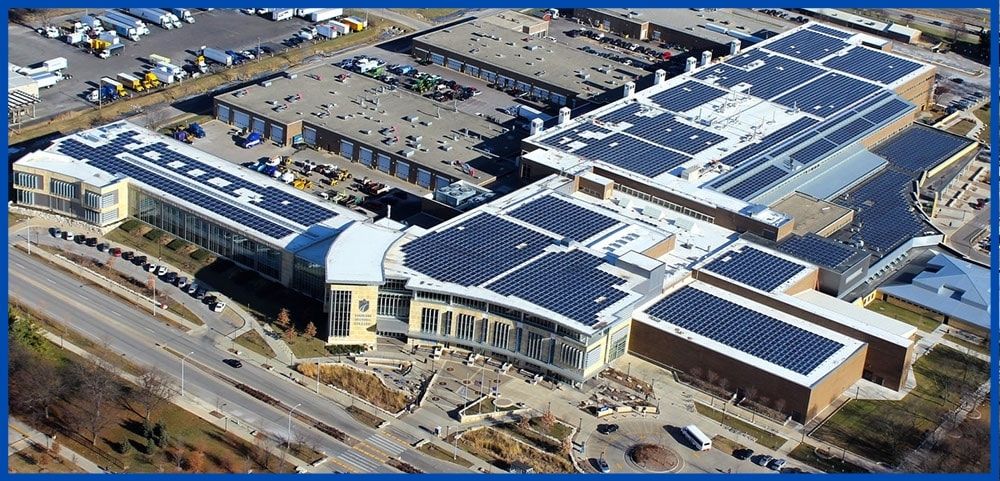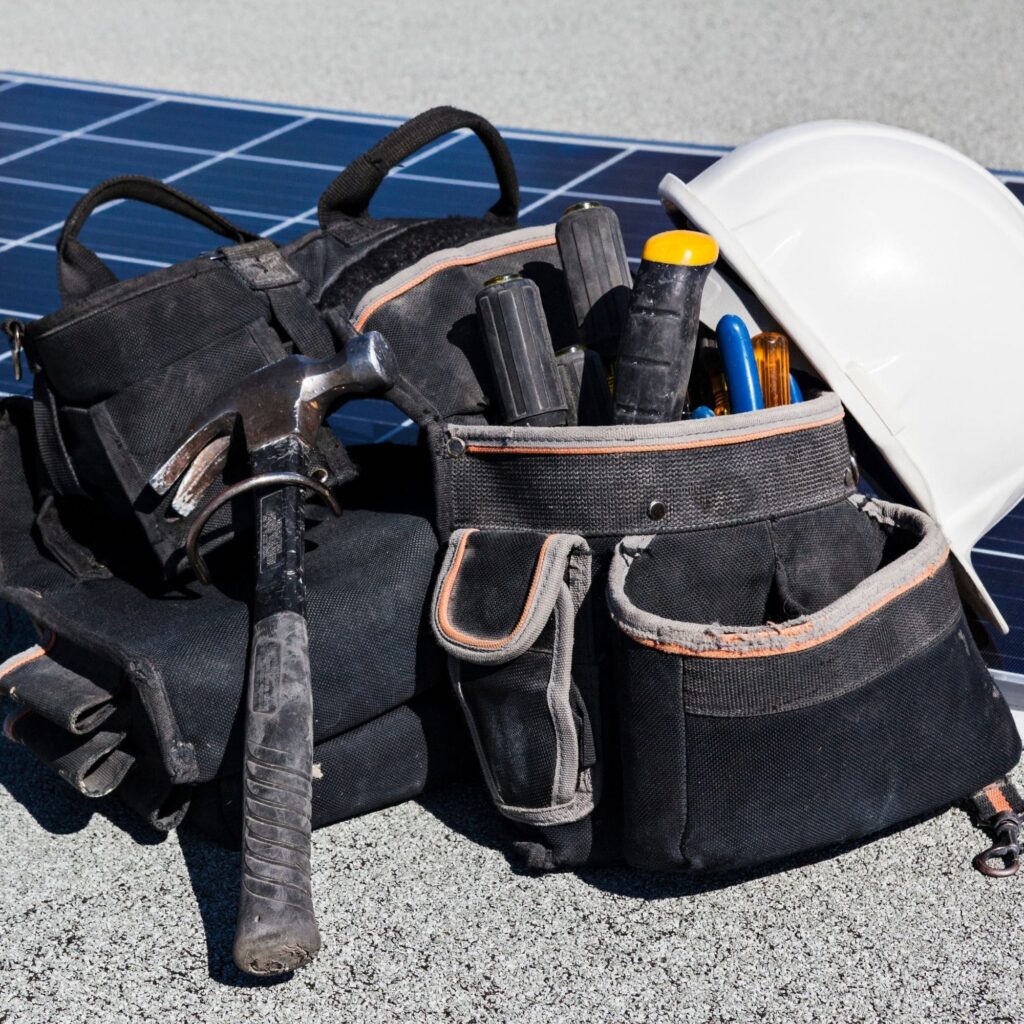
As of 2020, solar electricity is now the cheapest form of energy available for most of the world. The solar photovoltaic (PV) industry has been one of the fastest growing sectors of the economy for the past decade, and the solar workforce has been one of the fastest growing opportunities for employment.
Over the past several years, the scale of solar installations has grown from residential systems sized to provide energy for single family homes, to systems large enough to power commercial or industrial buildings, to community-owned systems large enough to power whole neighborhoods, to utility scale systems designed to support the greater electrical grid.
The increased scale and reduced cost of photovoltaic technology now makes solar PV an attractive investment for schools. Outside of personnel, energy is one of the largest operational costs that schools must address. School buildings consume considerable amounts of electricity, especially those that use electricity for heating and/or cooling of the building space.
Although there are substantial differences between school buildings, and substantial regional differences in retail electrical pricing, it is increasingly the case that investing in solar electricity can provide significant financial benefits to schools in most parts of the U.S. (and for the world as a whole).
The Center for Renewable Energy Advanced Technological Education (CREATE) is funded by the National Science Foundation and led by Madison Area Technical College in Madison, Wisconsin.
The CREATE network includes over 1000 faculty and administrators representing hundreds of colleges, universities, and public school districts in all 50 states and three U.S. territories. Several of these schools were pioneers and early adopters who have already completed solar installations for their institutions. Many more have solar projects under development, and countless others are certain to pursue solar projects in the upcoming years.

The materials included in this toolkit are based on the experiences of Madison College and other schools that are part of the CREATE network. Significant resources have also been contributed by the Midwest Renewable Energy Association, which administers the Solar on Schools grant program in the State of Wisconsin.
In 2019, Madison College commissioned the largest rooftop solar photovoltaic system in Wisconsin, and many of the tools and resources in this toolkit reference that system, or are derived from that installation project. Some of the materials included in this toolkit were originally presented at the 2020 American Society for Engineering Education conference, and this event is referenced in these resources.
The resources included in the toolkit are arranged in the Table of Contents roughly in order of relevance for a school that is considering a solar installation. Since most school districts operate more than one building, and since it is usually not possible to pursue multiple solar construction projects at the same time, the toolkit begins with documents describing a Solar Roadmap planning process to assess sites for their solar potential to prioritize investments.
For schools that proceed with solar projects, a draft Request for Proposals and a Scoring Rubric are included to help in the selection of solar contractors. A Timelapse Video of the Madison College solar installation is provided to help school officials visualize the solar installation process, and a Virtual Tour of the Madison College system is included to provide school officials with a vision of what a completed system looks like.
To help schools with public relations and the celebration of system commissioning, documents for planning Ribbon Cutting events, including draft Press Releases and a sample Gubernatorial Proclamation are provided. For ongoing outreach, a sample PV System Fact Sheet is included, along with a sample promotional video that was created by Madison College and Madison Gas and Electric utility.
Rounding out the toolkit is a paper and presentation from the American Society for Engineering Education conference titled Enlightened Education: Solar Engineering Design to Energize School Facilities, which won the Best Paper Award for the Energy Conversion and Conservation Division.
The Solar on School Toolkit is being published electronically so that it can be updated periodically to reflect changes in technology and to add more solar photovoltaic resources as they become available. Videos include closed captioning or a print transcript for the hearing impaired.
Template and sample documents have been provided in both Adobe PDF format to preserve original formatting and in Microsoft Word format to allow for easy editing by individuals seeking to customize the template forms for their own institutions.
The purpose of this toolkit is to flatten the learning curve for those seeking to install solar at their own institution. By executing solar installations on their facilities, schools can promote solar energy, provide students with pathways to energy careers, and yield economic benefits to their local communities.
Our hope is that this toolkit might accelerate the adoption of solar PV technology by a much larger number of schools and on a much larger scale.
1. Introduction, Rationale, Acknowledgments, References
2. 10 Step Guide to Create a Solar Roadmap
3. Solar Roadmap
4. Request for Proposals (RFP) for Solar Projects
5. RFP Scoring Rubric for Solar Projects
6. Solar Installation Timelapse Video
7. Virtual Tour of a Rooftop Solar System
8. Press Release 1
9. Press Release 2
10. Ribbon Cutting Event Planning Checklist
11. Ribbon Cutting Invitation
12. Ribbon Cutting Schedule and Remarks
13. Gubernatorial Proclamation
14. Solar System Fact Sheet
15. Solar Education Promotional Video
16. Enlightened Education Solar Engineering Design
17. Enlightened Education Presentation
18. Solar 101
19. Solar Case Studies: Brighter Future, A Study On Solar In U.S. Schools Third Edition, September, 2020
For more in depth information and resources specific to Wisconsin K-12 schools, please visit MREA’s Solar on Schools program.
Some of the content contained within this toolkit is based upon work that has been published and presented previously through the American Society for Engineering Education. The works include:
K.A. Walz. A virtual field trip of the largest rooftop solar photovoltaic system in Wisconsin (Enlightened Education: Solar Engineering Design to Energize School Facilities). Presentation for the Energy Conversion and Conservation Division. ASEE Annual Conference (2020)
K.A. Walz, J.B. Shoemaker, S. M. Ansorge, A. Gusse, and N. J. Hylla. Enlightened Education: Solar Engineering Design to Energize School Facilities. Best Paper Award, Energy Conversion and Conservation Division. ASEE Annual Conference Proceedings, Paper #30133 (2020)
Contributors for the various files and resources contained within the toolkit are recognized as authors and contributors within the individual documents and files. Fred Brechlin, Tom Helbig, Wes Marquardt, Mike Stark, and Mark Thomas were key contributors to the development and execution of solar projects at Madison College.
The multiple toolkit components were reviewed by many others that completed solar installations at their campuses including Roger Ebbage (Lane Community College), Deb Hall (Valencia Community College), and Andrew McMahan (Central Carolina Community College). Joe Sarrubbi (Interstate Renewable Energy Council) and Richard Lawrence (The Solar Foundation) also provided valuable insight to help in the development of this toolkit.
This toolkit is based upon work supported in part by the National Science Foundation under DUE Grant Awards # 1600934 and 2000714. The Madison College Solar Roadmap, Solar Procurement Request for Proposals (RFP), and the RFP Scoring Rubric were created with assistance from the Midwest Renewable Energy Association and funding from the U.S. Department of Energy Solar Energy Technologies Office Award Numbers DE-EE0006910 and DE-EE0008573.
Any opinions, findings, or recommendations expressed in this material are those of Madison College, the Center for Renewable Energy Advanced Technological Education, and the Midwest Renewable Energy Association. The information contained does not reflect the views, opinions, or advice of the National Science Foundation or the Department of Energy.
Ken Walz
Madison College & CREATE Energy Center
Science and Engineering Instructor
Amanda Schienebeck
Midwest Renewable Energy Association
Solar on Schools Program Manager
Nick Hylla
Midwest Renewable Energy Association
Executive Director
Gabie Temple
College of the Canyons & CREATE Energy Center
Co-PI and Communications Manager
Joel Shoemaker
Madison College & CREATE Energy Center
Electrical Apprenticeship Instructor
Ellen Barlas
Midwest Renewable Energy Association
Solar Workforce Manager
The Solar on Schools Toolkit is made freely available under a Creative Commons Attribution, Non-Commercial, Share Alike license (CC BY-NC-SA). Please view the Creative Commons License if you intend to copy and redistribute this material in any medium or format, or adapt, remix, transform or build upon this material. For a summary of the Creative Commons License, please view our full terms and disclaimers.
To access additional Energy Education Resources, visit our Resources page.
Copyright @ 2025 CREATE National Energy Center
This material is based upon work supported by the National Science Foundation under Grant #2201631. Any opinions, findings, and conclusions or recommendations expressed in this material are those of the author(s) and do not necessarily reflect the views of the National ScienceFoundation.